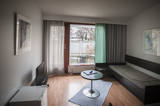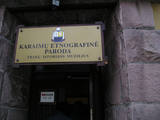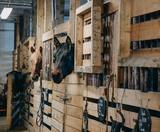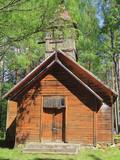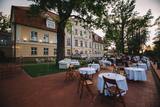| Nr | Nosaukums | Apraksts |
|---|---|---|
|
Motelis Marine atrodas netālu no Ekenäs centra un minūtes pastaigas attālumā no pludmales. Reģistratūra darbojas 24 stundas. Šis motelis piedāvā dažāda veida numurus, sākot no vienvietīgiem numuriem līdz lieliem ģimenes numuriem ar virtuvi. Katram numuram ir sava ieeja. Darbojas restorāns, kā arī ir sauna. |
||
|
Apskatāma līdz 17 m augstās Ragakāpas apkārtne, 100-gadīgas priedes. Garums 2 km (vienā virzienā!) Ietilpst Ragakāpas dabas parka teritorijā. |
||
|
Atrodas vēsturiskā rātslaukuma dienvidu malā. Jaunā rātsnama celtniecība (itāļu renesanses stilā, arhitekts O. Dīce) tika pabeigta 1860. gadā. Iespaidīgo celtni, kas nulle kā atjaunota, ir vērts apskatīt gan no āra, gan iekšpuses. Ir restaurēts rātsnama pulkstenis, ārējā fasāde, iekšējie interjeri un Lielā zāle. |
||
|
Viens no izteiktākajiem Latvijas piekrastes zemesragiem ar piejūras palieņu pļavām un 1875. g. celto bāku. |
||
|
Plāča centrā pie Inčukalna – Valkas autoceļa (A3) atrodas Teodora Zaļkalna darinātais piemineklis Ziemeļlatvijas atbrīvotājiem 1919. gadā. Uz pieminekļa iekalti Edvarta Virzas teiktie vārdi: „Kamēr vien labību šais laukos sēs, Jūs slavinās un godam pieminēs”. Uz pieminekļa attēlots zemnieks ar zobenu pie iejūgta zirga. |
||
|
Karaims are a small nation of Turkish decent who practise The Karaim religion which started developing around 8th century in Persia. Their language is still used in modern-day Lithuania. In the museum there are rooms not only dedicated to Lithuanian Karaite communities but also Poland's and Ukraine's. |
||
|
Atrodas ~ 0,4 km no Latvijas – Lietuvas robežas, Sventājas ielejas labā krasta nogāzē. Atrodama informācija, ka avotu tīrot, atklājusies 5 x 5 m ozolkoka „grīda”. Avots ir labiekārtots – virs tā slejas lapene ar niedru jumtu. Vēl pavisam nesen pie tā auga Latvijas dižākā ieva (nolūza), kuras vietā tagad kuplo biezs atvašu pulks. |
||
|
Vidzemē, Valmiermuižā, 19.gs. celtā ēku kompleksā, ko iekļauj mūra žogs, atrodas Valmiermuižas stallis un Valmiermuižas jātnieku skola. Tajā saimnieko Jurašu ģimene - zirgkopju, zirgu selekcionāru un vetārstu ģimene daudzās paaudzēs. Ir iespēja doties izjādēs, ekskursijās, kā arī tiek rīkotas radošās nometnes bērniem. |
||
|
Smilšakmens iežos veidojusies ala ar vairākām arkām, pīlāriem un nišām. Liepas Lielās Ellītes alas (Ellīte, Velna ceplis, Velna krāsns, Vella ala, Liepmuižas ala, Liepas ala) kopgarums ir nedaudz vairāk par 20 m, tās griestu augstums sasniedz 3,5 m, bet platums 5 m. No alas izplūst spēcīgs avots. Domājams, ka tā sākusi veidoties jau pirms 7000 gadu. Ala daudz postīta, 20. gs. sākumā no tās raktas arī baltās smiltis. Lielā Ellīte ir sena kulta vieta. Mūsdienās vieta labiekārtota, izveidota atbilstošs labiekārtojums. |
||
|
Atrodas Rīgas ielā 8 – skaistā, 1883. g. celtā jūgendstila ēkā . Muzejs (viens no Latgales lielākajiem un vecākajiem) tajā darbojas no 1959. g. (pats muzejs dibināts 1938. g.) un tā krājums vēsta par Daugavpils un tās apkārtnes vēsturiskajiem notikumiem. Tajā regulāri tiek rīkotas arī tematiskās izstādes, piedāvātas muzejpedagoģiskas programmas. Te vēl var apskatīt Daugavpilī dzimušā un pasaulē pazīstamā mākslinieka Marka Rotko (1903. – 1970.) gleznu reprodukcijas, kuras no 2013. gada plānots pārcelt uz M. Rotko centru Daugavpils cietoksnī. |
||
|
Krupenišku vecticībnieku kopienas lūgšanu nams celts 1908. gadā. Dievnama projekta autors ir inženieris I. Ivanovs. Šobrīd dievnams atrodas sliktā
tehniskā stāvoklī.
|
||
|
Pēc Livonijas valsts izveides, pāvests veltīja šo zemi Vissvētākajai Jaunavai Marijai. Tā radās Terra Mariana jeb Māras zeme. Ceļš Ludza – Rēzekne – Daugavpils ir sena tirdzniecības ceļa posms, kurš agrāk savienoja šodienas Viļņu un Kauņu ar Pleskavu, bet vēlākos laikos Sankt – Pēterburgu ar Varšavu. |
||
|
Saukts arī par Jēša vai Ieša ezeru. Salām bagātākais Latvijas ezers ar aptuveni 35 salām. Visvairāk salu ir ezera ziemeļaustrumu daļā, bet lielākā sala ir Lielā Lāču sala (45 ha), uz kuras pat savulaik atradusies viensēta. |
||
|
Mālpils muiža ir izcils klasicisma arhitektūras piemineklis. Tajā iekārtots arī gardēžu restorāns. Tā ēdienkarte mainās un tiek papildināta, mainoties gadalaikiem un izmantojot katrai sezonai raksturīgas veltes. Restorāns atkārtoti iekļuvis Latvijas labāko restorānu topā, pateicoties šefpavārei Aijai Gabrānei. |
||
|
Atrodas t.s. Baznīcu kalnā - Tautas ielā 2. Šo uzskata par vienu no krāšņākajiem Latvijas pareizticīgo dievnamiem, kura ārējo veidolu izrotā daudzo torņu kupoli. Tā celta 1905. g. kā Dinaburgas garnizona baznīca ar daudziem nozīmīgiem mākslas pieminekļiem interjerā, t.sk. 19. gs. ikonām. Dievnams ir ikdienā atvērts un apskatāms no iekšpuses. |
||
|
Taka izvijas augšup un lejup gar Pilsupes lejteces stāvajiem krastiem un atklāj skaistus skatus uz trīs balto smilšu atsegumiem (lielākais no tiem – t.s. Baltā kāpa, kas ir apmēram 20 metrus augsta un ir veidojusies pirms 6000 gadiem ). Apkaimes kāpu masīvs ir veidojies Litorīnas jūras periodā pirms vairākiem tūkstošiem gadu. Takas garums ir 900 m, un apskatei nepieciešamais laiks ir ~ 0,3 h. Tās apkārtnē ir atrastas akmens laikmeta apmetnes liecības. |
||
|
Saimniecības "Ances" Latvijas tumšgalves aitas aug tīrā vidē – Ziemeļvidzemes biosfēras rezervāta teritorijā, Igaunijas pierobežā, Naukšēnu pagastā, kur nekad nav intensīvi lietoti ķīmiskie augu aizsardzības līdzekļi un minerālmēsli. Aitas gan ziemā, gan vasarā brīvi pārvietojas, un nožogojums ganībās kalpo, pirmkārt, lai aizšķērsotu ceļu vilkiem un meža cūkām. Saimniecības ganāmpulkā tiek turētas tikai tādas tīršķirnes aitu mātes, kuras dzimušas kā dvīnes vai trīnes, t.sk. arī ģenētisko resursu dzīvnieki. Dzīvnieku priekštečiem ir tikai vienas šķirnes - Vācijas melngalves asiņu piejaukums. Aitas tiek lecinātas tikai ar augstvērtīgiem LT teķiem pa grupām janvārī, februārī un augustā, septembrī. |
||
|
Lauku mājā "Celmiņi" iespējams dzirdēt farmaceites Valentīnas Dāboliņas stāstus par veselību stiprinošiem ārstniecības augiem. Tiek piedāvāta augu atpazīšana un tēju vākšana, kā arī tēju degustācija un iegāde. |
||
|
Krogs "Minhauzens Pie Bocmaņa" atrodas Salacgrīvas centrā – Bocmaņa laukumā pie Salacas. Kādreiz tik pazīstamais krodziņš „Pie Bocmaņa” ir ieguvis jaunu interjeru ar barona Minhauzena tematiku. Latviešu virtuve: Siļķes salāti, siļķe ar biezpienu, zivju zupa, cūkgaļas krūtiņa ar sīpoliem, pelēkie zirņi ar speķi, ceptas aknas, cepta bute, cepta zandarta fileja, rupjmaizes kārtojums. |
||
|
Lielākais Slīteres nacionālā parka purvs – stingrā režīma
zona, kurā apmeklējumi ir aizliegti.
|
||
